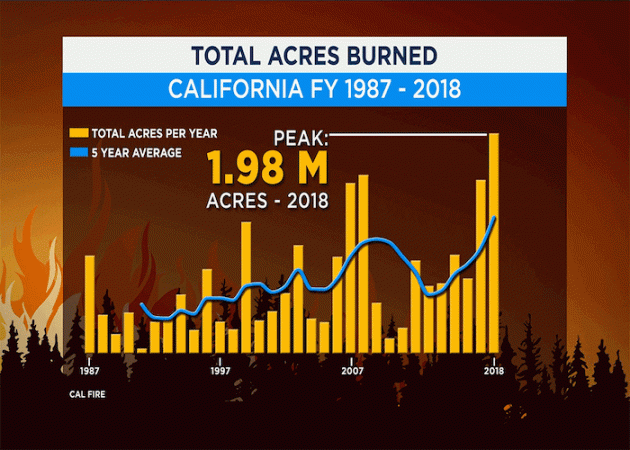With yet another devastating fire season underway, many California residents are wondering why there have been so many more destructive fires recently.
Is it because of climate change? Is it because of overgrown and neglected forests? Or is it because there are simply more people living in wildland areas than there used to be?
Experts say it could be all of the above.
"Every year it seems like fire season is longer," said Cal Fire assistant deputy director Daniel Berlant. "Every year it seems like we're having more devastating wildfires."
Cal Fire statistics show a large increase in the number of acres burned over the past 30 years. In 2018, it was a record-setting year in California, with 1.98 million acres burned. We've already eclipsed that number in 2020, with already 3.5 million acres burned. And it's not even October yet.

"Our fires seasons are getting longer," said Berlant. "Our summers are longer."
But LeRoy Westerling, professor of management of complex systems at UC Merced, said the large number of recent fires isn't only attributed to the fire season being longer than it used to be.
"It's not as simple as saying the fire season is longer," said Westerling. "It's also much more severe."
Westerling said climate change is a big factor in the ever-increasing number of wildfires. Data produced by the National Oceanic and Atmospheric Administration show the average overall temperature recorded in California during the month of September has increased by approximately four degrees over the past century.

Rising temperatures are especially critical in areas that depend on freezing temperatures to prolong the spring snowpack in the mountains.
"There's these large areas of forest that were typically a little below freezing in the spring, and we warmed it up now that in a lot of years it's above freezing in the spring," said Westerling. "So this big area melts off much sooner."
Besides rising temperatures, Westerling said climate change is also responsible for more extreme weather conditions than we experienced decades ago.
"The weather systems slow down and linger longer; there are longer dry spells and longer wet spells," said Westerling.
Westerling said longer droughts obviously dry out the forests and reduce fuel moisture. But longer and more intense wet seasons don't necessarily make up the difference, because even a record amount of snowfall can melt too fast for the trees to absorb all of that water.
Cal Fire spokesperson Daniel Berlant likened the phenomenon to trying to drink out of a fire hose.
"The amount of pressure, the amount of water, there's no way for your body to swallow it, and trees are no different," Berlant explained.
Westerling said that not only means an earlier dry season, but a longer time that fuels can become dry enough to burn in forest ecosystems. He uses the devastating 2018 Camp Fire in Paradise as an example, where fuel moistures have been declining over the past 40 years.

"The largest fires in California have been increasing, and this is in all kinds of ecosystems," Westerling said.
But Cal Fire said climate change isn't the only issue affecting the number of devastating wildfires. Berlant cited the increasing number of people who now live in the wildland areas, and the fact that he says 95% of fires started in California are human-caused, whether accidental or not.
"Definitely if you look back to the 1950s and 60s, there are a lot more people who live in the wildland-urban interfaces that have moved out of urban areas," Berlant said. "They want to be in areas where there are a lot more trees."
Berlant also cites more than 102 million acres of forest in California that have been neglected for at least 50 years. Some of this land is owned privately; the rest of it is managed by the state and federal government.
"Much of our forest is overstocked. It's not healthy," said Berlant, citing a number of reasons, including government restrictions. "California has some of the most stringent environmental regulations to insure we have good quality air, and that we're doing our part to reduce carbon emissions. But we're looking at continued ways to cut green tape, to cut out the bureaucracies, to make to easier to manage our forest in a sustainable fashion."
Berlant said the state has dedicated over a billion dollars over the next five years to fire prevention, fuel reduction and prescribed burning.
But it's not nearly enough according to Westerling, who said even if state and federal authorities double their investment, it's still just a drop in the bucket when you consider the millions of acres of forest that are decades behind in proper fuels reduction.
"If you just look at the Sierras, before we were treating 1% a year. That's the number I've heard from fuels managers in the Sierra Nevada forest," said Westerling. "Doubling that isn't getting us anywhere near to the fraction of the landscape that we need to treat."
Berlant agreed with that assessment, saying we're easily decades away from being in a position where forests in California are healthier. Not to mention the fact that some of the most devastating California wildfires aren't even burning in the forest.
Westerling pointed to the 2017 Thomas Fire, that burned mostly in chaparral areas.
"We've had a bunch of big fires, and a bunch of big fire seasons," Westerling said. "And that's going to be the case for a while."


